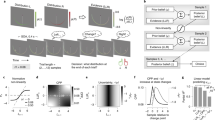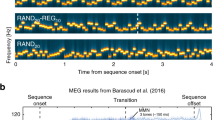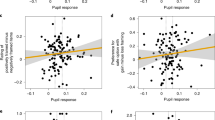Abstract
Effective decision-making requires integrating evidence over time. For simple perceptual decisions, previous work suggests that humans and animals can integrate evidence over time, but not optimally. This suboptimality could arise from sources including neuronal noise, weighting evidence unequally over time (that is, the ‘integration kernel’), previous trial effects and an overall bias. Here, using an auditory evidence accumulation task in humans, we report that people exhibit all four suboptimalities, some of which covary across the population. Pupillometry shows that only noise and the integration kernel are related to the change in pupil response. Moreover, these two different suboptimalities were related to different aspects of the pupil signal, with the individual differences in pupil response associated with individual differences in the integration kernel, while trial-by-trial fluctuations in pupil response were associated with trial-by-trial fluctuations in noise. These results suggest that different suboptimalities relate to distinct pupil-linked processes, possibly related to tonic and phasic norepinephrine activity.
This is a preview of subscription content, access via your institution
Access options
Access Nature and 54 other Nature Portfolio journals
Get Nature+, our best-value online-access subscription
$29.99 / 30 days
cancel any time
Subscribe to this journal
Receive 12 digital issues and online access to articles
$119.00 per year
only $9.92 per issue
Buy this article
- Purchase on Springer Link
- Instant access to full article PDF
Prices may be subject to local taxes which are calculated during checkout






Similar content being viewed by others
Code availability
Experiment code was created with Psychtoolbox-3 and custom MATLAB code. All behavioural and pupil analyses were created with custom MATLAB and R code. All code can be found at https://github.com/janekeung129/clicks-pupil. Code for fitting the DDM with sticky bound1,41 is provided at http://github.com/misun6312/PBupsModel.jl.
Data availability
The datasets generated and analysed during the current study are available from the corresponding author upon reasonable request.
References
Brunton, B. W., Botvinick, M. M. & Brody, C. D. Rats and humans can optimally accumulate evidence for decision-making. Science 340, 95–98 (2013).
Erlich, J. C., Brunton, B. W., Duan, C. A., Hanks, T. D. & Brody, C. D. Distinct effects of prefrontal and parietal cortex inactivations on an accumulation of evidence task in the rat. eLife 4, e05457 (2015).
Katz, L. N., Yates, J. L., Pillow, J. W. & Huk, A. C. Dissociated functional significance of decision-related activity in the primate dorsal stream. Nature 535, 285–288 (2016).
Yates, J. L., Park, I. M., Katz, L. N., Pillow, J. W. & Huk, A. C. Functional dissection of signal and noise in MT and LIP during decision-making. Nat. Neurosci. 20, 1285–1292 (2017).
Newsome, W. T. & Pare, E. B. A selective impairment of motion perception following lesions of the middle temporal visual area (MT). J. Neurosci. 8, 2201–2211 (1988).
Hanks, T. D. et al. Distinct relationships of parietal and prefrontal cortices to evidence accumulation. Nature 520, 220–223 (2015).
Gold, J. I. & Shadlen, M. N. Neural computations that underlie decisions about sensory stimuli. Trends Cogn. Sci. 5, 10–16 (2001).
Drugowitsch, J., Wyart, V., Devauchelle, A.-D. & Koechlin, E. Computational precision of mental inference as critical source of human choice suboptimality. Neuron 92, 1398–1411 (2016).
Faisal, A. A., Selen, L. P. & Wolpert, D. M. Noise in the nervous system. Nat. Rev. Neurosci. 9, 292–303 (2008).
Ma, W. J., Beck, J. M., Latham, P. E. & Pouget, A. Bayesian inference with probabilistic population codes. Nat. Neurosci. 9, 1432–1438 (2006).
Beck, J. M., Ma, W. J., Pitkow, X., Latham, P. E. & Pouget, A. Not noisy, just wrong: the role of suboptimal inference in behavioral variability. Neuron 74, 30–39 (2012).
Smith, P. L. & Ratcliff, R. Psychology and neurobiology of simple decisions. Trends Neurosci. 27, 161–168 (2004).
Osborne, L. C, Lisberger, S. G. & Bialek, W. A sensory source for motor variation. Nature 437, 412–416 (2005).
Kaufman, M. T. & Churchland, A. K. Cognitive neuroscience: sensory noise drives bad decisions. Nature 496, 172–173 (2013).
Sutton, R. S. & Barto, A. G. Introduction to Reinforcement Learning (MIT Press, Cambridge, 1998).
Daw, N. D., O’Doherty, J. P., Dayan, P., Seymour, B. & Dolan, R. J. Cortical substrates for exploratory decisions in humans. Nature 441, 876–879 (2006).
Griffiths, T. L. & Tenenbaum, J. B. Optimal predictions in everyday cognition. Psychol. Sci. 17, 767–773 (2006).
Cheadle, S. et al. Adaptive gain control during human perceptual choice. Neuron 81, 1429–1441 (2014).
Wyart, V., Myers, N. E. & Summerfield, C. Neural mechanisms of human perceptual choice under focused and divided attention. J. Neurosci. 35, 3485–3498 (2015).
Abrahamyan, A., Silva, L. L., Dakin, S. C., Carandini, M. & Gardner, J. L. Adaptable history biases in human perceptual decisions. Proc. Natl Acad. Sci. USA 113, E3548–E3557 (2016).
Urai, A. E., Braun, A. & Donner, T. H. Pupil-linked arousal is driven by decision uncertainty and alters serial choice bias. Nat. Commun. 8, 14637 (2017).
Barraclough, D. J., Conroy, M. L. & Lee, D. Prefrontal cortex and decision making in a mixed-strategy game. Nat. Neurosci. 7, 404–410 (2004).
Akrami, A., Kopec, C. D., Diamond, M. E. & Brody, C. D. Posterior parietal cortex represents sensory history and mediates its effects on behaviour. Nature 554, 368–372 (2018).
Joshi, S., Li, Y., Kalwani, R. M. & Gold, J. I. Relationships between pupil diameter and neuronal activity in the locus coeruleus, colliculi, and cingulate cortex. Neuron 89, 221–234 (2016).
Reimer, J. et al. Pupil fluctuations track rapid changes in adrenergic and cholinergic activity in cortex. Nat. Commun. 7, 13289 (2016).
Aston-Jones, G. & Cohen, J. D. An integrative theory of locus coeruleus-norepinephrine function: adaptive gain and optimal performance. Annu. Rev. Neurosci. 28, 403–450 (2005).
Rajkowski, J. Correlations between locus coeruleus (LC) neural activity, pupil diameter and behavior in monkey support a role of LC in attention. Soc. Neurosci. abstr. 19, 974 (1993).
Eldar, E., Cohen, J. D. & Niv, Y. The effects of neural gain on attention and learning. Nat. Neurosci. 16, 1146–1153 (2013).
Sara, S. J. The locus coeruleus and noradrenergic modulation of cognition. Nat. Rev. Neurosci. 10, 211–223 (2009).
Cavanagh, J. F., Wiecki, T. V., Kochar, A. & Frank, M. J. Eye tracking and pupillometry are indicators of dissociable latent decision processes. J. Exp. Psychol. Gen. 143, 1476–1488 (2014).
Murphy, P. R., Vandekerckhove, J. & Nieuwenhuis, S. Pupil-linked arousal determines variability in perceptual decision making. PLoS Comput. Biol. 10, e1003854 (2014).
Mather, M., Clewett, D., Sakaki, M. & Harley, C. W. Norepinephrine ignites local hotspots of neuronal excitation: how arousal amplifies selectivity in perception and memory. Behav. Brain Sci. 39, e200 (2016).
Eldar, E., Felso, V., Cohen, J. D. & Niv, Y. A pupillary index of susceptibility to decision biases. Preprint at https://www.biorxiv.org/content/10.1101/247890v1 (2018).
De Gee, J. W., Knapen, T. & Donner, T. H. Decision-related pupil dilation reflects upcoming choice and individual bias. Proc. Natl Acad. Sci. USA 111, E618–E625 (2014).
De Gee, J. W. et al. Dynamic modulation of decision biases by brainstem arousal systems. eLife 6, e23232 (2017).
Murphy, P. R., Boonstra, E. & Nieuwenhuis, S. Global gain modulation generates time-dependent urgency during perceptual choice in humans. Nat. Commun. 7, 13526 (2016).
Hauser, T. U., Moutoussis, M., Purg, N., Dayan, P. & Dolan, R. J. Noradrenaline modulates decision urgency during sequential information gathering. Preprint at https://www.biorxiv.org/content/10.1101/252932v1 (2018).
Eckhoff, P., Wong-Lin, K. & Holmes, P. Optimality and robustness of a biophysical decision-making model under norepinephrine modulation. J. Neurosci. 29, 4301–4311 (2009).
Nassar, M. R. et al. Rational regulation of learning dynamics by pupil-linked arousal systems. Nat. Neurosci. 15, 1040–1046 (2012).
Krishnamurthy, K., Nassar, M. R., Sarode, S. & Gold, J. I. Arousal-related adjustments of perceptual biases optimize perception in dynamic environments. Nat. Hum. Behav. 1, 0107 (2017).
Yartsev, M. M., Hanks, T. D., Yoon, A. M. & Brody, C. D. Causal contribution and dynamical encoding in the striatum during evidence accumulation. eLife 7, e34929 (2018).
Jepma, M. & Nieuwenhuis, S. Pupil diameter predicts changes in the exploration–exploitation trade-off: evidence for the adaptive gain theory. J. Cogn. Neurosci. 23, 1587–1596 (2011).
Servan-Schreiber, D., Printz, H. & Cohen, J. D. A network model of catecholamine effects: gain, signal-to-noise ratio, and behavior. Science 249, 892–895 (1990).
Angela, J. Y. & Dayan, P. Uncertainty, neuromodulation, and attention. Neuron 46, 681–692 (2005).
O’Reilly, J. X. et al. Dissociable effects of surprise and model update in parietal and anterior cingulate cortex. Proc. Natl Acad. Sci. USA 110, E3660–E3669 (2013).
Yechiam, E. & Telpaz, A. To take risk is to face loss: a tonic pupillometry study. Front. Psychol. 2, 344 (2011).
Aston-Jones, G., Rajkowski, J., Kubiak, P. & Alexinsky, T. Locus coeruleus neurons in monkey are selectively activated by attended cues in a vigilance task. J. Neurosci. 14, 4467–4480 (1994).
Acknowledgements
The authors received no specific funding for this work. We thank M. Alberhasky, C. Andrade, D. Carrera, K. Chung, M. de Leon, Z. Dzhalilova, A. Esprit, A. Foley, E. Giron, B. Gonzalez, A. Haddad, L. Hall, M. Higgs, M. Jacobs, M.-H. Kang, K. Kellohen, N. Kwatra, H. Kyllo, A. Lawwill, S. Low, C. Lynch, A. Ornelas, G. Patterson, F. Santos, S. Savita, C. Sikora, V. Thornton, G. Vargas, C. West and C. Wong for help with running the experiments. The funders had no role in study design, data collection and analysis, decision to publish or preparation of the manuscript.
Author information
Authors and Affiliations
Contributions
W.K. analysed the data. T.H. collected and preprocessed the data. T.A.H. and R.C.W. designed the experiment. W.K. and R.C.W. wrote the manuscript. All three authors contributed to interpretation of the results and critical discussion.
Corresponding author
Ethics declarations
Competing interests
The authors declare no competing interests.
Additional information
Publisher’s note: Springer Nature remains neutral with regard to jurisdictional claims in published maps and institutional affiliations.
Supplementary information
Supplementary Information
Supplementary Notes 1–5, Supplementary Figures 1–15, and Supplementary References.
Supplementary Software
Description: Custom code that implements the major analyses described in the paper
Rights and permissions
About this article
Cite this article
Keung, W., Hagen, T.A. & Wilson, R.C. Regulation of evidence accumulation by pupil-linked arousal processes. Nat Hum Behav 3, 636–645 (2019). https://doi.org/10.1038/s41562-019-0551-4
Received:
Accepted:
Published:
Issue Date:
DOI: https://doi.org/10.1038/s41562-019-0551-4
This article is cited by
-
Flexible categorization in perceptual decision making
Nature Communications (2021)
-
A divisive model of evidence accumulation explains uneven weighting of evidence over time
Nature Communications (2020)



